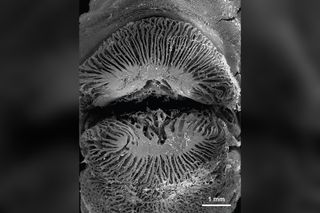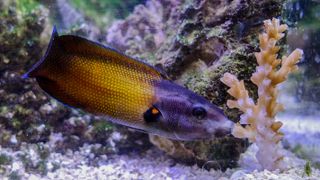Lip-Smacking Good! How 'Mushroom-Lipped' Fish Score Hard-to-Get Meals
Specialized, self-lubricating smackers are the key to the fish's slobbery success, scientists discovered. The wrasses' mouths are unusual, to say the least — their fleshy pucker is dramatically different from the lips of their cousins that don't dine on stinging corals.
Wrasses that don't eat corals have smooth, thin lips that don't quite cover their teeth. But L. australis' full and fleshy lips resemble a mushroom's gills: They're packed with thin, vertical, slime-slick membranes. Their lip surface is similarly covered in folds of tissue that secrete generous amounts of mucus, coating the lips like the world's gloppiest lip gloss, and protecting the fish from the corals' venom, according to a new study. [Photos: The Freakiest-Looking Fish]
If you've ever suffered from the dripping nose that accompanies a cold, just imagine that same sensation in your lips, and you'll have a pretty good idea of the tubelip wrasse's slimy adaptation, study co-author David Bellwood, a reef fish researcher and professor at the College of Science and Engineering at James Cook University in Australia, said in a statement.
The researchers captured high-resolution images of the fishes' lips using a scanning electron microscope, revealing the unusual mushroom-like folds that produced copious amounts of mucus.

This peculiar modification enables the wrasses to accomplish what only 128 species of reef fish (out of 3,000 species) can do: dine on coral flesh that's packed with stinging, needle-like structures and wrapped around a sharp skeleton.
To feed on these potentially mouth-slicing corals, the wrasses literally suck it up, the study authors wrote. High-speed video revealed that the fish position their mouths around their coral target, creating a seal with their mucus-coated lips to increase suction power, and then slurp up the outer layer of coral mucus and bits of its flesh.

Little is known about how fish use their lips, and the diversity of lip shapes among reef fishes raises intriguing questions about the variety of roles that lips might play in how fish eat, the authors wrote in the study.
Sign up for the Live Science daily newsletter now
Get the world’s most fascinating discoveries delivered straight to your inbox.
"One always assumes that fishes feed using their teeth," Bellwood said in the statement. But just as lips play a role in humans' eating, "the lips can be an essential tool" for fish as well, he added.
And lip service isn't the only ingenious use for mucus employed by this fish group.
Wrasses are also known to produce slimy mucous cocoons that act as a type of protective sleeping bag — a behavior that was long thought to protect the fish from predators, researchers reported in a study published online in the November 2010 issue of the journal Biology Letters. However, the scientists found that the fishes' slime "sleeping bags" act as a defense against bloodsucking parasites, much as mosquito nets protect humans against biting insects, the study authors wrote.
But not all mucus is created equal, and the chemical recipe for the tubelip wrasses' special mouth mucus is yet to be discovered. Deciphering the so-called "magic of the mucus," as the study authors called it, is the next slippery question that the researchers plan to address, they wrote in the study.
The findings were published online June 5 in the journal Current Biology.
Original article on Live Science.

Mindy Weisberger is an editor at Scholastic and a former Live Science channel editor and senior writer. She has reported on general science, covering climate change, paleontology, biology and space. Mindy studied film at Columbia University; prior to Live Science she produced, wrote and directed media for the American Museum of Natural History in New York City. Her videos about dinosaurs, astrophysics, biodiversity and evolution appear in museums and science centers worldwide, earning awards such as the CINE Golden Eagle and the Communicator Award of Excellence. Her writing has also appeared in Scientific American, The Washington Post and How It Works Magazine. Her book "Rise of the Zombie Bugs: The Surprising Science of Parasitic Mind Control" will be published in spring 2025 by Johns Hopkins University Press.










